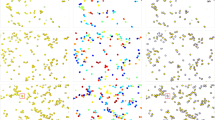Abstract
The anthracnose is one of the most serious diseases in the growth period of mango. In order to take preventive measures timely, it is indispensable to calculate accurate statistics on the distribution density of anthrax spores on the farm, which has challenges in accurate instance segmentation of adherent spores. Based on the traditional watershed algorithm, which treats the image as a morphological topography and segments the image by finding the lowest and highest points on the topography, we proposed the marked watershed algorithm combined with morphological preprocessing to realize the segmentation of adherent spores. Firstly, the spore images are preprocessed with morphology technique. Then the gradient values of the spore images are calculated. The segmentation of spores is performed in the gradient image by the watershed algorithm with foreground mark and background mark. The experimental result shows that our proposal has a better segmentation performance for adherent spores than the morphological method and the level set evolution.
Access this chapter
Tax calculation will be finalised at checkout
Purchases are for personal use only
Similar content being viewed by others
References
Li XL, Ma ZH, Sun ZY et al (2013) Automatic counting for trapped urediospores of Puccinia striiformis f. sp. tritici based on image processing. Trans Chin Soc Agric Eng 29(2):199–206
Hu QX, Tian J, He DJ, Ning JF (2012) Segmentation of plant lesion image using improved C–V model. Trans Chin Soc Agric Machin 43(05):157–161
Camargo A, Smith JS (2009) An image-processing based algorithm to automatically identify plant disease visual symptoms. Biosyst Eng 102:9–21
Hu ZH, Zhao YC (2019) The application and research of computer vision and machine learning in wisdom agriculture. Harbin Institute of Technology Press
Acharjya PP, Ghoshal D (2013) The role of structuring element in morphological image segmentation. Int J Sci Eng Res 4(7):2560–2569
Chen YZ, Huang YF (2009) Survey of Ncut in application of image segmentation. Comput Technol Dev 19(1):228–230
Zhao W, Wang XC, Li XH (2010) Image segmentation method based on top-hat transformation and FCM clustering. Comput Technol Dev 20(8):52–55
Wang PW, Wu XQ, Zhang MC (2006) Watershed segmentation based on multiscale morphological fusion. J Data Acquisit Process 21(4):398–402
Masood S, Sharif M, Masood A (2015) A survey on medical image segmentation. Curr Med Imag Rev 11(1):13–14
Bhargavi K, Jyothi S (2014) A survey on threshold based segmentation technique in image processing. Int J Innov Res Dev 3(12):234–239
Acknowledgements
This research was supported by Hainan Province Natural Science Foundation, China (619QN195, 618QN218), the National Natural Science Foundation of China (61963012), Key R&D Project of Hainan Province, China (ZDYF2018015), and Collaborative Innovation Fund Project of Tianjin University-Hainan University (HDTDU201907).
Author information
Authors and Affiliations
Corresponding author
Editor information
Editors and Affiliations
Rights and permissions
Copyright information
© 2020 Springer Nature Singapore Pte Ltd.
About this paper
Cite this paper
Wang, J. et al. (2020). Marked Watershed Algorithm Combined with Morphological Preprocessing Based Segmentation of Adherent Spores. In: Liang, Q., Wang, W., Liu, X., Na, Z., Jia, M., Zhang, B. (eds) Communications, Signal Processing, and Systems. CSPS 2019. Lecture Notes in Electrical Engineering, vol 571. Springer, Singapore. https://doi.org/10.1007/978-981-13-9409-6_157
Download citation
DOI: https://doi.org/10.1007/978-981-13-9409-6_157
Published:
Publisher Name: Springer, Singapore
Print ISBN: 978-981-13-9408-9
Online ISBN: 978-981-13-9409-6
eBook Packages: EngineeringEngineering (R0)




